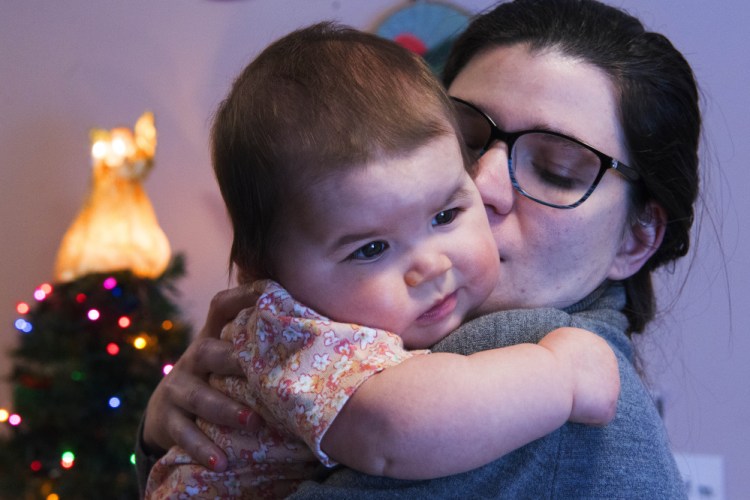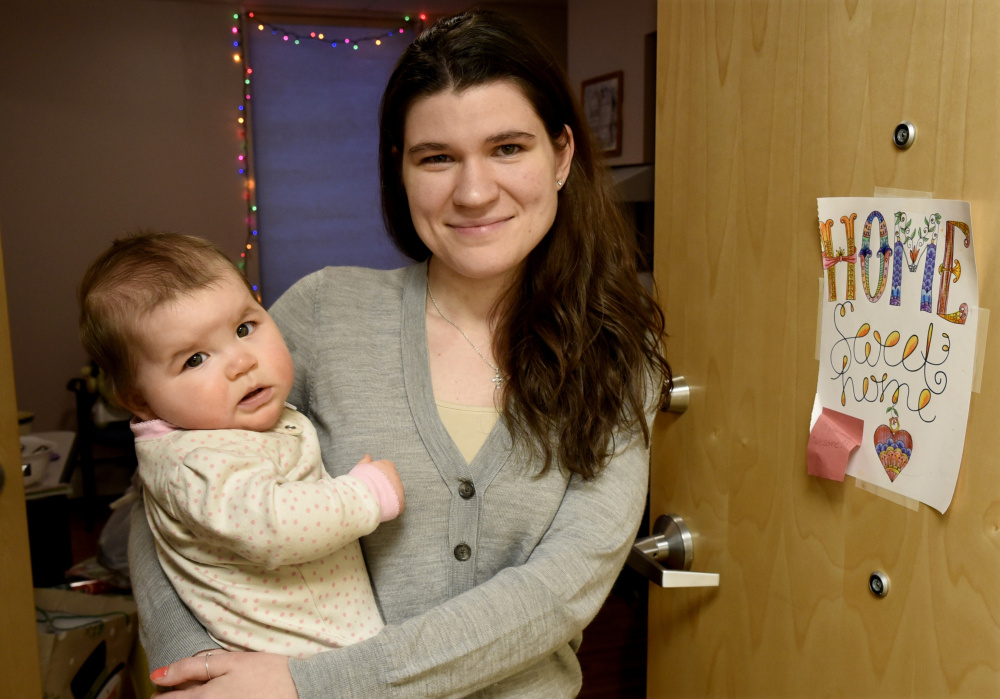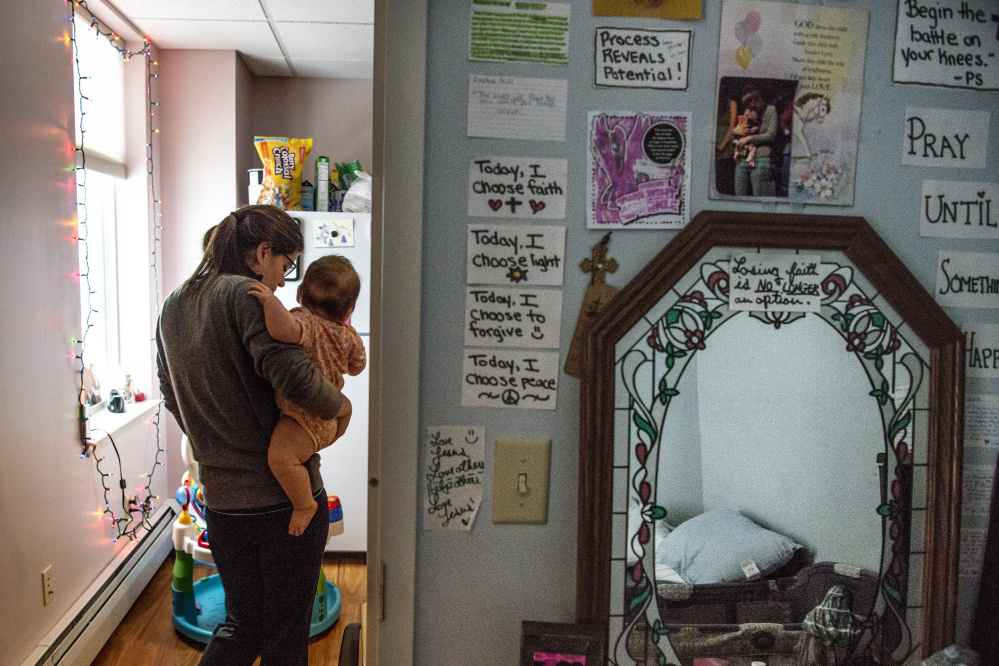WATERVILLE — Kayla Clifton and her 8-month-old daughter, Lilly, will spend Christmas at the Mid-Maine Homeless Shelter, but she does not see that as a bad thing.
After all, it was the shelter that took her in when she was in an unhealthy situation with nowhere else to go, and it is the shelter that is helping her get back on her feet.
“The staff is amazing. I wouldn’t have been able to get through it without them,” she said.
A single mother, Clifton, 26, is one of 52 people, 17 of whom are children, living at the shelter on Colby Street.
“We’re full – very full,” said the shelter’s executive director, Betty Palmer.
The guests at the shelter are there for various reasons, including loss of jobs and housing. Palmer said the lack of good, affordable housing in the area is a major reason.
“We have a mom and daughter here who were living at her father’s house and the house was condemned, so she was afraid to raise a child there and it’s just not safe,” Palmer said. “There’s no heat, no water.”
Those stories point to a trend in the region: heightened demand with a population that increasingly involves families and young children, and those affected by the opiate crisis.
“The moral of this story is that there is more demand than there is resource to meet it,” said John Richardson, executive director of the Bread of Life Ministries, which runs a soup kitchen on Water Street in downtown Augusta and shelters for families and veterans on Hospital Street.
“It’s not just bed resources; it’s all resources,” Richardson said. “There are not enough resources serving the folks who are addicted to drugs. It’s not just an Augusta thing. It’s a statewide thing.”
Palmer has been executive director of the Waterville shelter for more than seven years and has seen family homelessness increase by 35 percent – driven by the cost of affordable housing.
People earn only a certain amount of money, and with cuts over the last seven years in food stamps, housing and other federal funding, changes in the way social services are delivered and the determination of who qualifies, people have to make decisions about whether to spend money on food, medicine and other necessities, Palmer said.
Most poor people do not know people who own their own homes, and if they find themselves homeless, they can’t just move in with others who rent and whose landlords do not allow it, she said.
“Most leases discourage people from visiting,” she said. “It is a situation – affordable housing is a serious situation for our community.”
The only hope is for private housing development to occur, she said.
“Something has to break locally,” she said. “We have to figure it out at the local or state level. People keep taking stabs at it, but it’s such a big thing.”
The Waterville shelter does more than house and feed guests. It hosts career workshops so they develop job resumes and learn about what to wear to job interviews, what to say and how to present themselves. They also learn work ethics.
“We’re really giving people some soft skills to be a good employee for somebody,” Palmer said.
They get help in finding places to live. They are hired at places such as the Marden’s Surplus & Salvage store in Waterville, fast food restaurants and Educare Central Maine, where they work as education technicians, Palmer said. The average stay at the homeless shelter is 45 to 90 days, she said.
“Ninety-eight percent of the guests we place in housing are still stably housed three years later,” Palmer said. “Sixty-seven percent are employed.”
The shelter’s second floor has 12 new transitional apartments that were completed in March and house 18-to-24-year-olds who are working and attending school, Palmer said.
“We have several of them in colleges. Others are in programs to get ready to go to college in the fall,” she said.
BREAKING THE CYCLE
Clifton lives in one of those second-floor apartments, and the stable environment allows her to bond with her baby daughter.
She was pregnant in April when she arrived at the shelter, nervous and scared. She was not there long when she opted to go back to her former home to give birth to Lilly, but the living situation wasn’t any better, so she returned to the shelter after the baby was born. She said Palmer was supportive and did not judge her or tell her she never should have left.
“I was so grateful,” Clifton recalled.
She had her own room with a rocking chair and was able to care for her baby. The staff was empathetic and helped her through times when her infant was colicky.
“I was blessed with a great group of people that were very supportive – a great staff,” Clifton said.
In late June, she moved into one of the apartments on the second floor. It is the cleanest, nicest apartment she has ever lived in, she said. Clifton, who also has a 6-year-old daughter whom she sees on weekends, plans to get a driver’s license, go back to school and get a job. She worked at Family Dollar for about a year but had to leave to focus on her baby and her own health.
A couple of years ago, she was attending Kennebec Valley Community College in Fairfield but was unable to finish. Now she is working on paying her college bills with an eye toward returning to KVCC. She hopes to become a counselor one day and help others in need.
“I’ll work on it and I’ll get back in,” she said of KVCC. “I’m working on the application.”
This is not the first time Clifton has been at the shelter. She stayed there two years ago when her 6-month-old son died. It was a difficult time.
“I would be nowhere without this program and what it did for me,” she said.
The shelter, which has high insurance costs, survives on donations and gets less than 25 percent of its funding from the state and federal government, Palmer said.
“The rest comes from our community, and we live in a very generous community,” she said. “We count on the community’s kindness and compassion to take care of people. I tell people statewide, we have an awesome community shelter. If we didn’t have the community support that we have, we would not be able to survive on what the federal and state government gives us.”
The shelter was organized 27 years ago and has been in its building at 19 Colby St. for five years. With two full-time and 17 part-time employees, the shelter has an outreach program called Building Family Futures, which works with eight to 12 families a year in the community who are rent-burdened or in the process of becoming homeless. The shelter also operates a program called Pathways to Opportunities, for 18-to-24 year-olds, which helps them with education and work structure.
“We put 13 young adults back in school this year,” Palmer said, adding that some were living in the shelter and some were living on the streets. Now they are housed in stable situations and enrolled in local colleges, she said.
HOMELESS FOR HOLIDAYS
Asked what shelter guests need for Christmas, Palmer said they need new, warm clothing of all sizes, and especially larger sizes for men and women.
“We always need pajamas this time of year. We’re doing pretty well on hats and mittens, so we’re all set there. But we could use coats and boots.”
Gift cards for older teens and adults – even small gift cards – for businesses within a half-mile of downtown would be most welcome, as the guests walk everywhere, Palmer said.
“Even a $5 gift card gives somebody coffee every day for a week at Burger King, and that’s a nice, warm feeling,” she said. “They’re out looking for jobs and apartments, and being able to get a cup of coffee and warm up is nice. Any of those kinds of things are very, very helpful.”
People also may drop off nonperishable food, which is always needed, Palmer said. “They can make cookies and drop them off,” she said.
The shelter has a wish list on its Web page, shelterme.org, where readers can learn more about the facility. Prospective volunteers may just show up at volunteer training sessions, held 2 to 4 p.m. the second Sunday of every month, Palmer said.
She said shelter guests who have relatives they can visit for Christmas were helped with bus tickets so that they could leave for the holiday. A party was held Wednesday at the shelter, and Kris Kringle visited.
Those with no family or friends will eat food and play games on Christmas. It can be a blue day for some, and Palmer said she encourages guests to talk about that.
“We tell them, it’s OK to be blue. It’s Christmas, but it’s OK to miss people. It’s OK to miss your life. There’s a lot of grief in homelessness.”
MEETING DEMAND
In Augusta, as the winter gets underway, the number of people seeking help from the agencies that provide services to the homeless is steady.
“You would think the desire for beds in a homeless shelter would go up when it gets cold out there, but there doesn’t seem to be a ton of rhyme or reason to it,” said Richardson, of the Bread of Life Ministries.
In addition to the soup kitchen that Bread of Life operates, the nonprofit runs shelters for families and veterans on Hospital Street, and manages 83 apartments throughout the city.
The only data Bread of Life has comes from the annual Point in Time homelessness survey that’s conducted every January. The results give a snapshot view of homelessness in Kennebec County, but doesn’t break down numbers for individual communities.
Other considerations also influence the ability to establish what the homeless population in Kennebec County is, he said.
“The challenge is that according to federal guidelines, you are not homeless if you are couch-surfing. If you are staying with someone who is willing to let you stay with them one or two nights, you are not homeless. They are not counted,” Richardson said, “but they definitely do not have stable housing.”
The organization has refined how it estimates the demand for its services. This year, it moved away from counting all phone calls to finding the number of individuals seeking services.
From the information he’s collected, he said those are people who are couch-surfing, living in cars or living in tents in warmer months, or living outside.
Bridging the Gap also offers services to the homeless and those who are struggling, through the Augusta Community Warming Center, Addie’s Attic Clothing Bank, and Everyday Basics Essentials Pantry.
“We serve probably around 3,000 unique individuals in the Greater Augusta area,” project director Sarah Miller said, “but they are not all necessarily homeless.”
Richardson said Bread of Life’s shelters are full throughout the year. To meet the chronic need for shelter, the organization is planning to add on to both its shelters in the next year.
Twelve more beds will be added to the family shelter, and three more rooms will be added to the veterans’ shelter.
Richardson said the project could cost $200,000 to $240,000. To date, about $140,000 has been raised, and Bread of Life has $34,000 from the Home Depot Foundation that can be used for construction materials.
“We would like to start breaking ground next spring or summer, but we have to get our plans to the city. It shouldn’t be a problem, because we’re zoned for that.”
Staff Writer Jessica Lowell contributed to this report.
Send questions/comments to the editors.






Success. Please wait for the page to reload. If the page does not reload within 5 seconds, please refresh the page.
Enter your email and password to access comments.
Hi, to comment on stories you must . This profile is in addition to your subscription and website login.
Already have a commenting profile? .
Invalid username/password.
Please check your email to confirm and complete your registration.
Only subscribers are eligible to post comments. Please subscribe or login first for digital access. Here’s why.
Use the form below to reset your password. When you've submitted your account email, we will send an email with a reset code.